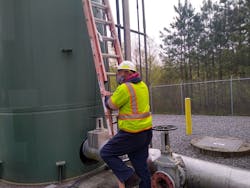5 Breakthrough Solutions to Recover Stronger: One Water
About the author:
Radhika Fox is CEO for US Water Alliance. Fox can be reached at [email protected].
Times of upheaval can lead to moments of radical change. COVID-19 has upended life across America, disrupting business as usual in every sector and shifting the way we relate to and work with one another. In many ways and across many sectors, the pandemic exposes and reinforces structural challenges and social inequities. In the water sector, this plays out through access to water, the cost of water services, our governance structures, and even how we fund and deliver those water services. We have a unique opportunity in how we respond and recover from COVID-19. We can take this moment of disruption to rework a system that ensures both the financial stability of utilities and the equitable distribution of water services. If we do this, we can emerge stronger than before, as a resilient water sector ready for the challenges that lie ahead. It is up to innovative and committed leaders to bend the arc toward such a transformation in how we view, value and manage our nation’s water systems.
Consider the ways in which the water sector has been disrupted. Even though service shutoffs are the primary mechanism available to utilities for nonpayment, many have put a moratorium on shutoffs and are actively restoring service to those who do not have it. Utilities and cities are working together to find ways around institutional barriers to help provide emergency universal water access. Water utilities are leaning into the use of digital tools for everything from operations to public meetings in a time of social distancing. Researchers from Australia to America are accelerating studies to see if waste streams can serve as early warning systems to detect areas where COVID-19 may be spreading. Six months ago, would we have imagined such rapid pivots were possible in the water sector? Indeed, the coronavirus pandemic is seriously disrupting how we view, value and manage water systems in America and globally.
Water utilities are often described as risk adverse and slow to change. And with good reason—they exist to protect public health and the environment. Yet, big shifts in how we provide water service have happened in a matter of weeks because protecting that same health in this moment requires speed and nimbleness. Can this disruptive moment also be a source of lasting transformation in the water sector—towards a landscape that is more integrated, sustainable and equitable?
As an organization, the US Water Alliance believes One Water is the best approach to build a future where water benefits people, businesses, and the environment. Here we offer five breakthrough solutions that can help the nation recover stronger from the current public health and economic crisis.
1. Price water to reflect its true value and the cost of service.
Despite its essential nature, investment in water infrastructure has not kept pace as pipes, pumps and plants reach the end of their expected life-spans. Costs have been heavily subsidized, rates have been kept artificially low, and now the country would have to fill a $1.2 trillion dollar gap just to achieve a good state of repair for existing systems.
The water sector is now facing the compounded difficulty of providing an essential service during the pandemic. But One Water leaders who have found a solution to price water services appropriately are better able to serve their customers at this critically important time. Buffalo Sewer Authority began addressing the issue of the city’s urgent water needs in 2019 by creating a new rate structure, and at the same time, it expanded bill assistance programs still in use today. The rate increase and the assistance program expansion gave the bond credit rating agency Moody’s more confidence in the authority’s credit worthiness, ultimately resulting in a better credit rating. This allowed it to borrow at lower costs and save customers money over the long-term. By adopting rate structures that better reflect the needs of water systems, we can start to close the investment gap and continue to serve communities.
2. Provide affordable, universal access to water.
Water must be safe, reliable, and affordable for everyone to protect and ensure public health. As many media stories have pointed out, however, not everyone is able to wash their hands to prevent disease transmission. Seattle Public Utilities and the city of Seattle moved quickly to remedy this public health gap by establishing hygiene stations for Seattle’s homeless population, who are particularly vulnerable to the coronavirus. Seattle Public Utilities is also offering relief to utility customers in the form of deferred payment plans to mitigate the economic strain of the pandemic.
The utility was able to move quickly in part due to its One Water approach, which meant working across its own departments and with other city and regional departments to implement these solutions. By recognizing the importance of water to public health and integrating its response with other departments, Seattle Public Utilities worked to improve public health in its community during an unprecedented global pandemic.
3. Catalyze utility consolidation and partnerships.
There are currently around 51,000 community water systems and 15,000 wastewater systems in America, all of which are frontline organizations that provide essential public health services. Such a vast landscape makes tackling big water challenges—like implementing emergency measures during a pandemic—difficult to do effectively and quickly to meet the needs of the public.
Utility partnerships, regionalization, and consolidation can all build the capacity to tackle big problems efficiently by building operational resilience and integrating planning across drinking water, wastewater, storm water, and other municipal and regional departments. When the drinking water utilities in Little Rock and North Little Rock, Arkansas consolidated to create Central Arkansas Water, the utility was able to equally distribute costs, maintenance, and customer service functions to better meet the needs of the region. Although this first consolidation agreement was signed in 2001, Central Arkansas Water has since expanded service to several more communities through consolidation and partnership. The financial benefits and improved resiliency of Central Arkansas Water is still serving the area today.
4. Deploy smart utility operations at scale.
Digital solutions like remote sensing technology, modern billing and customer service systems, and intelligent water systems provide operational resilience and allow utilities to do more during times of crisis. EJ Water Cooperative Inc. has the technology to control aspects of its water treatment facility remotely, even while working from home.
Wastewater utilities can also use technology to track data from sewer systems to find hot spots where the coronavirus may be spreading, which is what Northeast Ohio Regional Sewer District is doing in partnership with the U.S. Centers for Disease Control and Prevention. Implementing and scaling these technologies across the sector will help to give every community a resilient water system, no matter what the future holds.
5. Rebuild trust in water systems.
Many Americans are stockpiling bottled water, yet for most, the water from their tap is perfectly safe. The challenge of eroding public trust is not new for the water sector, but it is more important than ever to restore America’s faith in water systems. The good news is that One Water leaders are modeling practices to restore trust.
Pittsburgh Water and Sewer Authority (PWSA) is committed to maintaining trust through the COVID-19 pandemic. Its investments in digital solutions allow it to continue communicating with its customers in real-time and remotely. PWSA also embraces “water democracy” and convenes resident advisory committees that involve customers in the decision-making process on policies and programs to address affordability and lead risks. Ensuring trust during times of crisis—by starting prior to crisis—can build public will for One Water solutions, during the pandemic and into the future.
The water sector is providing an essential service to Americans during the COVID-19 pandemic. Utility workers are unsung heroes keeping water systems running to protect public health and community well-being. At the same time, the water sector is on the precipice of enduring
financial pressure.
How will we meet this moment? Will we rise to the challenge together and utilize this moment of disruption to accelerate progress? At the US Water Alliance, we believe the One Water approach is more important than ever. One Water leaders are proving why an integrated, holistic approach to water management is at the heart of what it means to recover stronger. Let’s focus on these five breakthrough solutions and meet this moment and chart a better water future in America.



